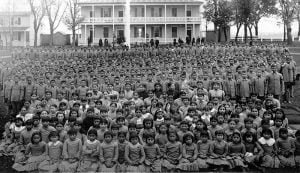
The Carlisle Indian School is situated in the heart of the great Pennsylvania agricultural belt on the edge of Carlisle, in the beautiful Cumberland Valley, about nineteen miles from Harrisburg, the capital of Pennsylvania one hundred twenty miles from Washington DC. The climate is very healthful, there being great extremes neither of cold nor of heat.
For years there had been a cavalry barracks located on the present site of the school. In the early history of the Colonies, this had been a frontier military post, and it was here that, in 1775, Benjamin Franklin made a treaty of peace with the Indian Tribes of Pennsylvania.
During the Revolutionary War, a number of Hessian prisoners were brought to Carlisle, following the battle of Trenton, and incarcerated under military surveillance. While held as prisoners, they erected a large, stone guardhouse, of unique construction, which is still standing at the south entrance to the grounds. It is one of the most historic buildings in this part of the state.
In July, 1863, when the Southern army invaded Northern territory and hostilities culminated in the battle of Gettysburg, Carlisle was shelled, and the buildings of the post were burned. These were rebuilt in 1865.
The post had long been used as a training school for cavalry. It was abandoned by the military authorities during the early seventies, and was donated to the Interior Department in 1879 for the purpose of beginning an educational establishment for Indians. This was the first school of its kind to be opened by the government, and the first to receive congressional recognition and appropriation.
On October 6, 1879, the first party of Indians, numbering eighty-two, arrived from the Sioux Reservation, after an exciting journey of much interest to the public. The second party, containing forty-seven Indians, came the following November from the Kiowa, Cheyenne, and Pawnee tribes of Oklahoma.
The school is supported by the federal government, and it has been specifically provided for by congress since 1883.
- Carlisle to Train Indian Youth for Citizenship
- Purpose
- Buildings and Plant
- Admission of Students
- Student Life at Carlisle Indian School
- Student Government and Outing
- School Government
- Physical Culture
- Athletics
- Outing System
- Course of Study at Carlisle Indian School
- Academic Courses
- Academic Education
- Business Department
- Telegraphy Department
- Native Indian Art
- Music
- Agriculture
- Boys’ Industries
- Household Arts
- Record of Graduates
- Record of Living Graduates
- Administrative Officers
